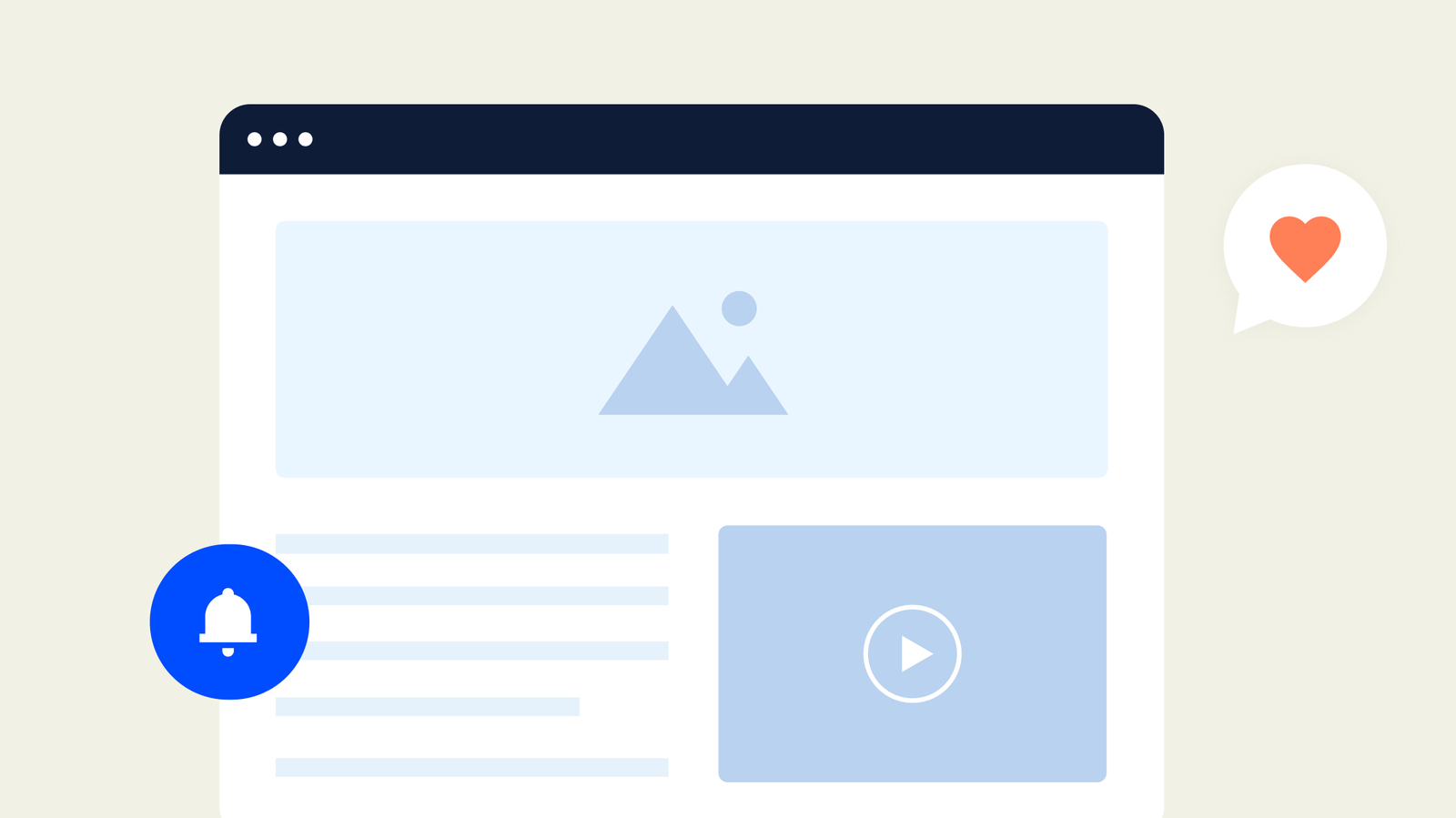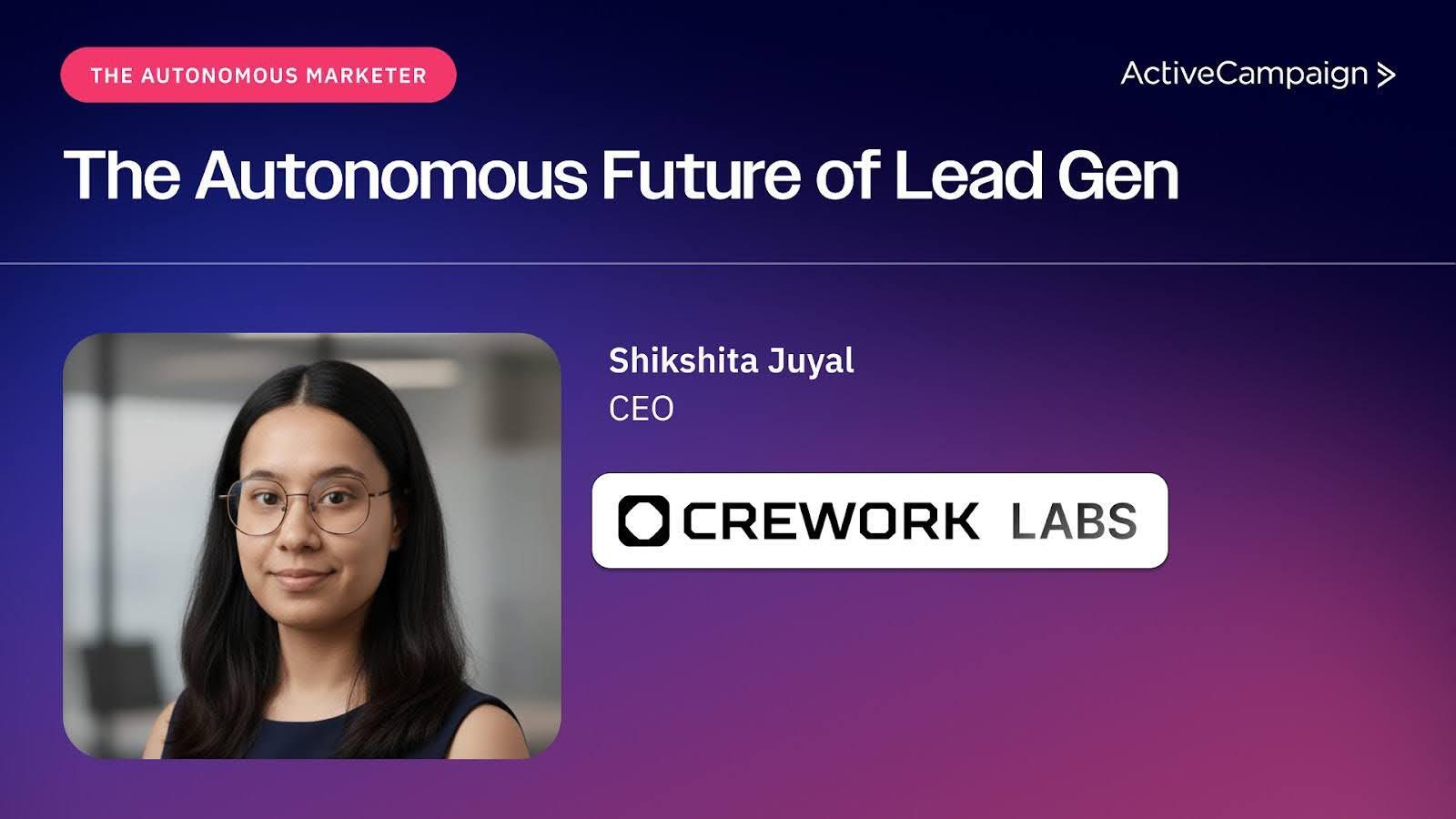There are many factors to consider as you begin your journey to become a content creator.
Do you know what niche you'll be in? What about how you'll engage with your audience? Will that be on mainly one social platform or multiple? Will you use email marketing and build a newsletter to market yourself? Have you considered how to segment your audience and personalize the experience for each individual who interacts with your brand? What about monetizing your content and turning people from prospects to paying customers?
All of this may seem daunting as you think about pursuing a career in content creation but don't worry too much. We've covered everything you need to know in our content creator series below. From starting your journey to adopting a CRM platform and building automated email workflows, we walk you through it all.
So, let's start with the basics.
What is a content creator?
A content creator is someone who produces and distributes various types of content across different platforms such as social media, blogs, YouTube, podcasts, etc. Content creators can produce a wide range of content including videos, articles, images, podcasts, infographics, and more. They often have a specific niche or area of expertise that they focus on, and they engage with their audience by creating content that is informative, entertaining, or both.
Content creators may work independently or as part of a team, and they typically rely on social media platforms, websites, and streaming services to reach their audience and monetize their content through various means such as advertising, sponsorships, merchandise sales, and crowdfunding.
Plus, there are many different types of content creators who thrive on different platforms using different strategies. Some companies may hire a dedicated creator for a particular medium (video production, blog writing, graphic design, etc.), while others may enlist the help of freelancers or creative agencies.
The most popular types of creators are:
• The writer (think blogger, content marketer, copywriter, journalist, freelancer)
• The videographer (think YouTube creator, brand video specialist, educational/tutorial content creator)
• The podcaster (think personal brand podcaster, comedy or entertainment personality, creative educator, industry trends and tips podcaster)
• The social media influencer (think nano, micro, macro, or mega influencer, TikTok, Instagram, Facebook, Twitch personality, brand deal aficionado, affiliate marketer)
• The photographer (think visual content creator, graphic designer, illustrator, portfolio sites, event photographer, online presence on social media)
Each type of content creator will need to market themselves a little differently depending on a variety of factors. We've created a guide on just this with all the best practices you'll need to promote yourself as a successful content creator.
How creators can use CRM to elevate their marketing
Content creators, marketers, bloggers, podcasters, social media managers, and other flavors of creators are always thinking about how to best manage the relationships they have with their clients, customers, sponsors, partners, and collaborators.
If you’re a creator yourself, have you thought about how to do this as your business scales? For content creators with smaller teams or even working as a solopreneur, relationship management is a huge lever to pull as your content grows in popularity.
This is where CRM (customer relationship management) software comes into play. Creators can use a CRM to streamline their processes and enhance their content creation efforts.
Some of the benefits of using a CRM tool as a creator include:
- Audience management: A CRM tool can help you manage your audience contacts and organize them into segments based on demographics, interests, engagement level, or other criteria.
- Performance tracking: CRM tools can monitor metrics such as engagement rates, click-through rates, and conversions to evaluate the effectiveness of their content and make data-driven decisions to optimize future content strategies.
- Lead generation and nurturing: With a CRM tool creators can track leads, follow up with personalized content, and analyze lead interactions to improve lead conversion rates.
- Better customer segmentation: With the wealth of data CRM tools harbor, you can organize your audience into different segments based on things like product preferences, common pain points, and buying behaviors.
- Automating your business: Most CRM tools on the market include some form of marketing automation. As you set up the automations that make sense for your strategy, you’ll feel confident that your best offers are being sent, your follow-ups are timely, and your customers are satisfied with the level of customer support you’ve created.
- Boost in sales and revenue: You can leverage the data in your CRM platform to create perfectly targeted campaigns and relevant promotions that work together to drive more revenue for the business.
How your CRM can boost customer engagement
So, you've set up your CRM and are starting to see the benefits. If you're turning prospects into paying customers, you can’t stop there. A drop-off of meaningful engagement is the easiest way to lose valuable customers.
With your CRM, you can track content engagement over time, and identify what converts well and what doesn't. But how can you use this data to boost engagement where you're seeing a dip? There are four main ways a CRM tool can help.
Analyzing contact data
Your CRM will collect contact data of varying degrees, including things like their purchase history, website behavior, product preferences, event sign-ups, demographic information, and more.
By analyzing this data, you can generate a report in your CRM that will help you understand your customers on a deeper level and identify common behavioral patterns. In turn, you’ll know which customers to segment together in order to engage them with relevant content and messaging.

With ActiveCampaign, you can organize your contacts into segments based on specific preferences or actions they’ve taken.
Segmenting your customers will allow you to understand the differences between certain customer segments and create ultra-targeted marketing campaigns for each one. This personalization drastically improves the chances of your customers engaging with your content through email, social media, your website, SMS, or any other marketing channel.
Tracking customer interactions
CRM platforms are great for tracking customer interactions over different mediums. This could be through touchpoints like your website chatbot, social media comments, email marketing campaigns, customer service chat, and phone calls.
When you have this interaction data recorded in your CRM, you’re able to identify if a customer may be disengaged with one medium but could be more responsive through another. Say you’re sending SMS messages to one customer and notice they haven’t replied. By identifying this info in your CRM, you can test different channels in the hopes of capturing their attention.
How creators can build an audience with email marketing
There are many benefits that come along with standing up an email marketing strategy. As a content creator, you have the opportunity to create email content that drives meaningful traffic to your site, boosts audience engagement, and fields real customer feedback, all while building an audience that cares about your brand.
Studies show that 81% of B2B marketers say their most used form of content marketing is email newsletters.
There are endless benefits to content creators taking advantage of email marketing including driving traffic to your social channels, having a direct line of communication with your audience, and being able to nurture different types of leads with different messaging thanks to segmentation and personalization.
When content creators lean into email marketing, the sky's the limit on their success. Don't be late to the game that creators just like you are already playing (and winning).
How creators can write an engaging newsletter
A newsletter is one of the simplest and most effective ways to stay in touch with your audience. Newsletter marketing is powerful and there are some businesses that only sell with newsletters. But there are also a lot of hurdles to leap along the path to creating a good weekly newsletter. And especially as a content creator.
A lot of questions like:
- What should you send in a newsletter?
- How often should you email your subscribers?
- What should your email newsletter design look like?
- What email newsletter tool should you use?
There are four steps you need to take to start sending great content creator newsletters and how to make them interesting enough that people can’t wait to read them.
Decide what your newsletter is used for
It’s one thing to think “I should really send a newsletter.” It’s another to actually send it.
You'll need to decide on:
• Topic: What you’ll write about
• Content types: What kind of content you’ll include in your newsletter. Blog posts, videos, ebooks? How does your email newsletter fit into your content marketing strategy?
• Newsletter name: What you’ll name your newsletter
• Design: What your newsletter will look like
• Timing: How often you’ll send out your newsletter. How will it fit in with your editorial calendar?
• Metrics: How you’ll measure your newsletter’s success
• And, last but not least, goals: What you want your newsletter to accomplish
If you know the goals of your newsletter, a lot of the other questions answer themselves.
Know what to put in your newsletter
Your newsletter should be a mix of your unique differentiators, the key needs of your specific audience, and calls to action that drive people to take the next step in the customer journey.
One thing to remember — your newsletter is not about you. Your newsletter is about your audience’s needs and pain points. But the way you talk about those needs and pain points should always be informed by your unique perspective.
Why is audience segmentation critical for content creators?
For content creators, segmenting your audience is about moving beyond one-size-fits-all content to deliver personalized experiences that resonate with different audience segments. Whether you are a blogger, a YouTuber, a social media influencer, or a content marketer, understanding and implementing audience segmentation can transform your approach, increase your content’s impact, and ultimately drive more meaningful engagement with your audience.
There are different criteria to segment your audience:
- Demographic segmentation: This involves categorizing the audience based on demographic factors like age, gender, education, or income. For instance, the content that appeals to teenagers might differ significantly from what resonates with adults in their thirties.
- Behavioral segmentation: Here, the focus is on the audience’s behavior. This could include their purchasing habits, website browsing patterns, or engagement with previous content. Understanding these behaviors helps tailor content that aligns with their interests and interactions.
- Engagement level segmentation: Another approach is to segment the audience based on their engagement levels surrounding your content, such as emails sent or blog posts. This can range from highly engaged users who regularly interact with your content to passive viewers who seldom engage. A common use for this is to gauge potential customers and how likely they are to convert.
The benefits of personalized content for content creators
Personalized content is about delivering experiences that are relevant, engaging, and valuable to your audience. Whether you are crafting a blog post, a video, or a social media campaign, personalization is key to elevating your content. It’s the bridge between understanding your audience through segmentation and engaging them with content that feels custom-made for their interests, behaviors, and preferences.
Gaining a thorough understanding of your audience is the cornerstone of personalizing your content effectively. To know who your buyer persona is, you must first know who your target audience is.

There are many benefits to personalizing your content including increasing engagement, building customer loyalty, and boosting conversion rates.
How to start automating your marketing campaigns
At its core, automated marketing aims to deliver the right message to the right people at the right time, without manual intervention every step of the way. This is a huge lever for content creators looking to improve efficiency, maintain consistency when posting, and scale their content strategy as they grow.
Many different types of creators can tap into the power of automation including bloggers, YouTubers, podcasters, content marketers, and social media influencers. Once you lean in, you can select the right marketing automation tool for you (depending on your niche and overall goals) and begin to build a powerful marketing motion that works for you.
There are different types of automation as well, from email automation to social media automation to content management and scheduling. Even as a content creator just starting out, it's never a bad idea to look into the tools available to you and try a few out to see which fits best.
Never miss a blog post
Using AI technology during the content creation process
Among content creators, this subject is controversial. Can you trust AI automation tools to help you create content while still maintaining that human touch? The short answer is yes if you use it wisely.
Generative AI has revolutionized the efficiency of the content creation process in several key ways:
- Time-saving on repetitive tasks: AI excels in handling repetitive, time-consuming tasks that are a part of the content creation process. For instance, AI can automate the process of data collection, keyword research, and even basic structuring for a piece of content. This automation significantly reduces the time spent on these tasks, allowing content creators to focus more on creative aspects.
- Streamlining workflow: AI content tools often come with features that streamline the workflow. They can quickly analyze large volumes of data, provide insights, and even suggest content improvements based on trends and analytics. This saves time and makes the process more efficient by offering data-driven suggestions and strategies.
- Enhancing productivity: AI enables content creators to be more productive by taking over routine tasks. They can create more content in less time, with AI handling aspects like SEO optimization, content formatting, and even ensuring that the content meets certain quality standards. This increased productivity is a significant advantage in a field where content must constantly be updated and refreshed.
Plus, AI’s ability to analyze data for content personalization and targeting is a game-changer. It starts with an in-depth understanding of audience behaviors and preferences, which AI does by analyzing interaction data, social media posts, and user feedback. This analysis allows AI to identify patterns and preferences, making it possible to create content that resonates with specific audience segments.
Tools like ActiveCampaign use AI for sophisticated audience targeting and content relevance, giving you the power to segment your audience based on behaviors and preferences, track user behaviors to trigger relevant emails, and understand audience interaction data to improve future content.
Why creators should adopt conversion rate optimization techniques
Are you noticing that the content you create pulls in visitors and traffic but doesn't seem to be converting? While new traffic and visitors should be a focus as you build more content, getting your existing leads to sign up for a trial and convert is what will sustain your business and lead to long-term growth.
This may be where you should start to incorporate conversion rate optimization techniques into your strategy.
Conversion rate optimization (CRO) is the process of increasing the percentage of website visitors who take a desired action, whether that’s making a purchase, signing up for a newsletter, filling out a form, or any other action that aligns with the goals of the website owner. The main objective of CRO is to maximize the effectiveness of a website in converting visitors into customers or leads.
Why is conversion rate optimization important?
Your conversion rate is the metric you can measure to understand how successful you are in converting new prospects. When you know your conversion rate, you'll know if you need to A/B test and improve different pages across your website to create a more user-friendly and educational experience that will communicate your value to visitors and encourage them to engage with your business.
But the secret is, you should always be optimizing your content, even if you're converting well.
Predictive analytics can change how you manage content
Predictive analytics offers content creators valuable insights into audience behavior, preferences, and trends. By leveraging predictive analytics tools, creators can forecast which content topics resonate most with their audience, leading to more effective content creation. Predictive analytics lets creators personalize their content recommendations and marketing messages, enhancing audience engagement and loyalty.
But the benefits of predictive analytics don't stop at content creation. They extend to content distribution strategies as well. By identifying patterns in audience interactions and predicting future trends, you can optimize your content distribution, maximize reach, and achieve your marketing goals more efficiently. This is how predictive analytics helps you stay relevant and successful in the ever-evolving landscape of content creation and marketing. Check out our article on email marketing for content distribution for more information.
Predictive analytics is a powerful tool for content creators to gain actionable insights, improve content relevance, and enhance audience engagement. By integrating predictive analytics into their workflows, creators can unlock new opportunities for growth and success in the ever-evolving landscape of content creation and marketing.
Why does loyalty marketing matter?
Loyalty marketing is designed to retain customers and increase recommendations through various tactics such as discount codes, special offers, gifts (including gift cards), and referral and rewards programs. For content creators, this is especially important if you're focused on growing your audience and keeping them interested in your content/brand.
According to our coupons report, 91% of consumers are willing to recommend an online store to family and friends in exchange for a coupon good for their next purchase.
Apart from this, there are many reasons why you should consider baking loyalty marketing into your strategy. After all, it costs 5x more to acquire a new customer than to retain a current one.
While this exact figure will depend quite heavily on factors specific to your company (your average purchase amount, industry, customer acquisition cost, particular retention tactics you employ, etc.), you can be confident that a dollar invested in customer loyalty and retention will be more valuable to the bottom line than if invested in acquisition.

No matter if you include a discount code in an email or build an entire loyalty program, investing in loyalty marketing will take you far in the long run.
Subscribe to the best newsletters for content creators
Subscribing to and reading a variety of newsletters is a great way to stay up-to-date on trends, industry news, social media algorithm changes, and recent developments in the creator world. They include curated articles, takeaways, videos, and thoughts to ponder on, all in one packaged-up piece.
Newsletters can teach you many things from influencer marketing on Instagram to optimizing your blog to tips from successful creators themselves. There are plenty of newsletters that cater to content creators and we've put together a list of the 13 that offer valuable insights and actionable advice straight from the creators already working in the field.
Best content marketing platforms
Finding the right tools can make all the difference in transforming your creative process and optimizing your projects. Whether you're a solo creator, part of a dynamic startup, or leading content initiatives within an established brand, having the perfect platform can revolutionize the way you craft, manage, and distribute your content. That's why picking the right content marketing platforms tailored specifically for content creators is so important.
From generating and refining content ideas to enhancing distribution and analyzing performance, the right platform serves as an indispensable ally in simplifying tasks and maximizing impact. It can also change how you create and manage your content.
Never stop learning
This post is part of our Content Creator series that delves into essential strategies that empower content creators – from those working independently to those creating content for large organizations and everyone in between. Discover all of the resources below.
As a creator, there are endless opportunities for you to learn how to market yourself as you grow. In a world with so much noise, it's even more important to listen to your audience and make their experience with your content one to remember. This is no easy feat.
As we talked about earlier, automating your marketing campaigns can work in the background for you and give you time back to focus on the future of your content.
If you're in the market for an automation tool, give ActiveCampaign a test drive today with a free trial.








